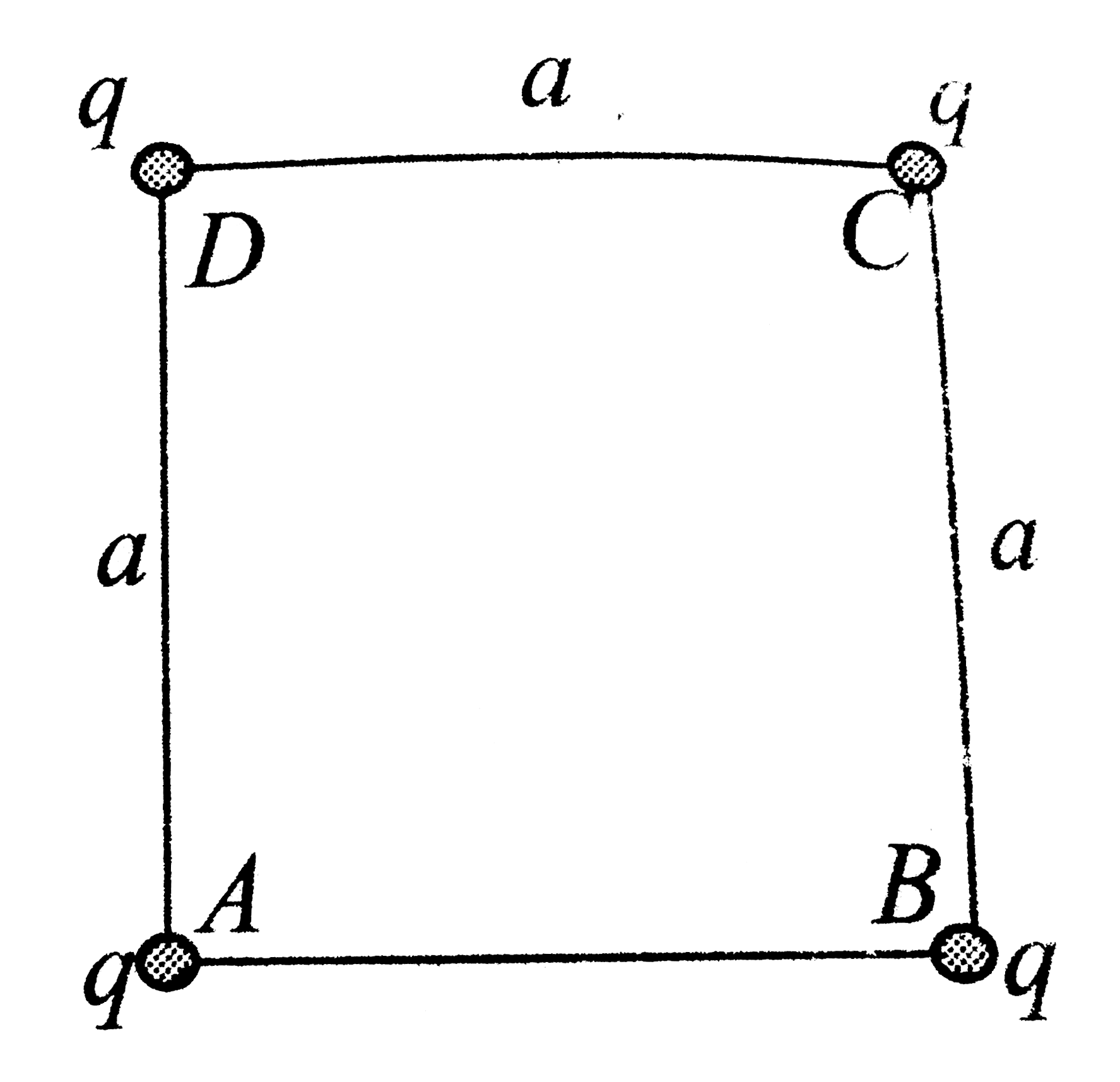Four identical charges q are kept on each vertices of a square of side a. Calculate the extra amount of work done in bringing a Q charge from infinity to the centre of the square.
To solve the problem of calculating the extra amount of work done in bringing a charge Q from infinity to the center of a square with four identical charges q at its vertices, we can follow these steps:
Step 1: Understand the Configuration
We have a square with side length a and four identical charges q placed at each vertex. We need to find the work done in bringing a charge Q from infinity to the center of the square.
Step 2: Determine the Potential at the Center
The potential V at a point due to a point charge is given by the formula:
V=14πϵ0qr
where r is the distance from the charge to the point where we are calculating the potential.
Step 3: Calculate the Distance from the Center to a Vertex
The distance from the center of the square to any vertex can be calculated using the Pythagorean theorem. The center of the square is at a distance of:
r=a√2
from each vertex.
Step 4: Calculate the Total Potential at the Center
Since there are four identical charges q, the total potential V0 at the center of the square due to all four charges is:
V0=V1+V2+V3+V4=4⋅14πϵ0qa√2
This simplifies to:
V0=4q√24πϵ0a=q√2πϵ0a
Step 5: Calculate the Work Done
The work done W in bringing the charge Q from infinity to the center is given by:
W=Q⋅V0
Substituting V0 into this equation gives:
W=Q⋅q√2πϵ0a
Final Answer
Thus, the extra amount of work done in bringing the charge Q from infinity to the center of the square is:
W=Qq√2πϵ0a
We have a square with side length a and four identical charges q placed at each vertex. We need to find the work done in bringing a charge Q from infinity to the center of the square.
The potential V at a point due to a point charge is given by the formula:
V=14πϵ0qr
where r is the distance from the charge to the point where we are calculating the potential.
The distance from the center of the square to any vertex can be calculated using the Pythagorean theorem. The center of the square is at a distance of:
r=a√2
from each vertex.
Since there are four identical charges q, the total potential V0 at the center of the square due to all four charges is:
V0=V1+V2+V3+V4=4⋅14πϵ0qa√2
This simplifies to:
V0=4q√24πϵ0a=q√2πϵ0a
The work done W in bringing the charge Q from infinity to the center is given by:
W=Q⋅V0
Substituting V0 into this equation gives:
W=Q⋅q√2πϵ0a
Thus, the extra amount of work done in bringing the charge Q from infinity to the center of the square is:
W=Qq√2πϵ0a
Topper's Solved these Questions
- ELECTROSTATIC POTENTIAL AND CAPACITANCE BOOK - MODERN PUBLICATIONCHAPTER - ELECTROSTATIC POTENTIAL AND CAPACITANCE EXERCISE - PRACTICE PROBLEMS 3
3 Videos
- ELECTROSTATIC POTENTIAL AND CAPACITANCE BOOK - MODERN PUBLICATIONCHAPTER - ELECTROSTATIC POTENTIAL AND CAPACITANCE EXERCISE - PRACTICE PROBLEMS 4
7 Videos
- ELECTROSTATIC POTENTIAL AND CAPACITANCE BOOK - MODERN PUBLICATIONCHAPTER - ELECTROSTATIC POTENTIAL AND CAPACITANCE EXERCISE - PRACTICE PROBLEMS 1
10 Videos
- ELECTROMAGNETIC WAVESBOOK - MODERN PUBLICATIONCHAPTER - ELECTROMAGNETIC WAVESEXERCISE - CHAPTER PRACTICE TEST
14 Videos
- MAGNETISM AND MATTERBOOK - MODERN PUBLICATIONCHAPTER - MAGNETISM AND MATTEREXERCISE - CHAPTER PRACTICE TEST FOR BOARD EXAMINATION
16 Videos
Similar Questions
Three identical point charges q are kept on each vertices of an equilateral triangle of side a. Calculate the work done in slowly moving the charges to the mid points of each side, covering the shortest possible distance.
View SolutionTwo similar particles of mass m and charge q are kept on the vertices of an equilateral triangle of side l. Calcualte the work done in moving another particle of charge Q from the third vertex to the centroid of the given triangle.
View Solution
Knowledge Check
Three equal charges Q are placed at the three corners of an equilateral triangle of side length a. Work done in shifting a charge q from infinity to the centroid of the triangle is
A3Qq4π∈0aB3Qq4π∈0√3aC3√3Qq4π∈0aD√3Qq4π∈03aFour equal charges Q are placed at the four corners of a square of each side is 'a'. Work done in removing a charge −Q from its centre to infinity is
AzeroB√2q2π∈0aC√2qπ∈0aDq2π∈0aFour equal charges Q are placed at the four corners of a square of each side is 'a'. Work done in removing a charge −Q from its centre to infinity is
A0B√2Q24πε0aC√2Q2πε0aDQ22πε0a
Four point charges are placed at the corners of a square of side l. Calculate potential at the centre of square.

View SolutionTwo identical charges of magnitude 0.4 mC are placed on diagonally opposite vertices of a square of side 10 cm. Calculate the amount of work done in slowly moving one of the charges from diagonally opposite vertex to adjacent vertex.
View SolutionFour identical charges q are placed at the corners of a square of side a. Find the potential energy of one of the charges due to the remaining charges.
 .
.
View SolutionFour identical point charges q are placed at four corners of a square of side a. Find the potential energy of the charge system.
 .
.
View SolutionA charge of 0.5 nC is placed at the centre of an equilateral triangle of side 10 cm, calculate the work done in bringing a charge of 0.1 nC from infinity to any vertices of the triangle.
View Solution
